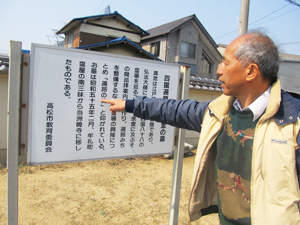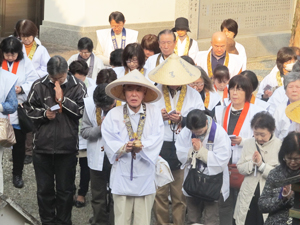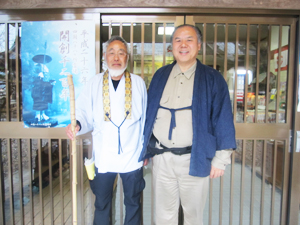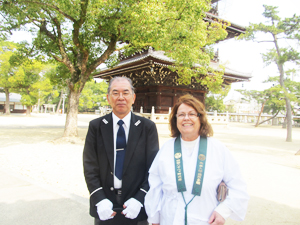Article in Cultural News 2014 May Issue:
Pilgrimage: Los Angeles visitors glimpse historical temples in Shikoku

Ruth Handy of Jizo Peace Center in Los Angeles visits Jizoji Temple in Tkushima prefecture. (Cultural News Photo)
By Shige Higashi, Editor and Publisher of Cultural News
My preparation for the Shikoku Pilgrimage began in the late 2013 when Ruth Handy of the Jizo Peace Center in the northern mountains of Los Angeles suburb asked me to organize a small group to visit some temples of the Shikoku Pilgrimage for a few days in the spring of 2014.
I have visited Shikoku from Los Angeles for more than 10 times, and I have friends in Takamastu, Tokushima, Matsuyama, and Niihama. It is not difficult for me to make hotel reservations and to find local transportation for the short version of the Shikoku Pilgrimage, but I did not know much about the 88 temples on the route of the Shikoku Pilgrimage.
The first person I asked about the temples was Bishop Taisen Miyata of Koyasan Buddhist Temple in Little Tokyo, Downtown Los Angeles. In 1984, Bishop Miyata has published English guidebook “A Henro Pilgrimage Guide to the Eighty-Eight Temples of Shikoku Island, Japan.” “Henro” is the Japanese term which people of Japan refer pilgrimages of Buddhist temples. In 2013, this guide book was revised and becomes available to purchase a copy for $25.
The request from Ruth was to prepare an itinerary of visiting temples which have enshrined statues of Jizo Bosatsu (Bodhisattva) as holy objects. When asked, Bishop Miyata immediately gave me the names of six temples: No. 5, Jizoji; No. 19, Tatsueji; No. 20, Kakurinji; No.25, Shinshoji; No. 37, Iwamotoji; and No. 56, Taisanji.
Then I narrowed these temple lists to only two: Jizoji in Tokushima prefecture and Iwamotoji in Kochi prefecture. In spite of the fact that several persons were interested in this tour, only Ruth and myself were able to go to Shikoku in March 2014.
Before preparing the Shikoku tour, I already started organizing the “Tohoku Pilgrimage” for observing the third anniversary of the 2011 Great Eastern Japan Disaster. From March 10 through March 14, I led the “Tohoku Pilgrimage” across Iwate, Miyagi, and Fukushima prefectures with 5 people from California and 3 people from Tokyo.
I started a trial version of the Shikoku Pilgrimage with Ruth from Tokyo on the day after the “Tohoku Pilgrimage” was disbanded. I chose Takamastu City in Kagawa prefecture as our ‘base camp” for the Shikoku Pilgrimage. We flew in Takamatsu from Haneda Airport of Tokyo.
Actual our basecamp was the Takamastu Terminal Hotel located across the JR Takamastu Station. Takamastu Terminal Hotel is a small hotel but the owner of the hotel has used to foreign travelers. On the Day One in Takamastu, we were invited to the historical Ritsurin Japanese Gardens by the tourism department of the Kagawa Prefectural Government.
 Prof. Harunori Shishido explains about histories of Shikoku temples. (Cultural News Photo)
Prof. Harunori Shishido explains about histories of Shikoku temples. (Cultural News Photo)On the Day Two, we met Professor Emeritus Harunori Shishido of Kagawa University for the first time. I was introduced to him through Kagawa’s tourism department. Prof. Shishdo teaches economics at the business school of Kagawa University, and out of the campus he leads an association with the name of the Network for Pilgrimage and Alms.
The Shikoku Pilgrimage route is one of the few circular-shaped pilgrimages in the world. It includes 88 designated temples and numerous sacred sites where Kukai, the pioneer monk of the Japanese Buddhism in the early 9th century, is believed to have trained himself and have spent time then.
Kukai, 774 – 835, is also known posthumously as “Kobo-Daishi” or the Grand Master Who Propagated the Buddhist Teaching. “O-Daishi-sama” is the honorable title which pilgrims usually refer Kukai.
Beside the 88 designated temples of the Shikoku Pilgrimage, there are over 200 temples dubbed as “bangai” (not designated) along the route of the pilgrimage. Many “bangai” temples are also worth to visit.
As the first leg on the Day Two, Prof. Shishido took us to Susakiji Temple at Mure area within Takamastu city boundary. According to the legend, Susakiji was founded by Kukai, but Susakiji is not designated as the 88 temples. Susakiji is a relatively small temple but has a beautiful garden.
Our destination on the Day Two was Jizoji Temple at Itano town in Tokushima prefecture. Along the route to Jizoji, we stopped at the gateway to No. 85, Yakuri Temple at Mure, Henro Museum and No. 88, Okuboji Temple (the Temple of A Large Hollow) at Sanuki city in Kagawa prefecture.
Okuboji Temple is surrounded with huge cliffs, mountains, and rocky bluffs. In commemoration of his journey to China in the early 9th century, Kukai enshrined his “Shakujo” stick, which is made of metallic stick with rings on top to make rattling sounds. Likewise, modern pilgrims leave all their staves in the temple because Okuboji Temple is designated as the last stop of the pilgrimage.
 Pilgrims at Jizoji Temple in Tokushima prefecture. (Cultural News Photo)
Pilgrims at Jizoji Temple in Tokushima prefecture. (Cultural News Photo)After Okuboji Temple, we drove toward east along Yoshino River to Itano in Tokushima prefecture for No. 5, Jizoji Temple (the Temple of Earth-Bearer). According to the legend, a two-inch-tall statue of Jizo Bosatsu of Victory was carved by Kukai, and enshrined in the temple in the early 9th century. In the 13th century, the Jizo Bosatsu of Victory was replaced with a large statue of Enmei Jizo (Jizo Bosatsu of Longevity) by monk Jokan, the renovator of the temple.
Jizoji Temple is also known with the display of so called “500 statues of Rakan (Arhat) at the hall corridor within the temple campus. Colorful and dynamic postures of numerous Rakan statues attracts many visitors and take them to the atmosphere of the ancient time. These Rakan statues were carved by two monks in the 18th century.
After Jizoji Temple, we spent short time at No. 6, Anrakuji Temple in Kamiita town of Tokushima prefecture and looked inside of “shukubo” accommodation. Before we returned to Takamastu, we glimpsed No. 1, Ryozanji Temple at Naruto city in Tokushima prefecture.
On the Day Three, Prof. Shishido drove for two hours to bring us to No. 37, Iwamotoji Temple (the Temple of Rocky Root) at Shimanto town in Kochi prefecture. Iwamotoji is located in the commercial area of Shimanto town, and it takes only five minutes to walk from JR Kubokawa Station to this temple.
Iwamotoji is known not only for the only temple which has five holy statues, but also for 575 pieces of artworks which covered the ceiling of the Hondo main hall of the temple. We stayed at “shukubo” accommodation of this temple. Prof. Shishido returned by himself to Takamatsu after he dropped us at Iwamotoji Temple.
I met a pilgrim from Chitose, Hokkaido at this temple. I happened to meet him at a bathroom and a dining room of “shukubo.” He was Akira Takahashi, 68-year-old, retired personnel of Japan’s national guard. His story touched my heart.
Mr. Takahashi lost his 23-year-old son by a car accident when he was 52-year-old. He became deep depression since then. Mr. Takahashi started the Shikuku Pilgrimage after he retired from the national guard service at the age of 54. He was on his tenth entire Shikoku Pilgrimage at this time.
If walked, the entire route of the pilgrimage is about 12,00 kilometers long. Mr. Takahashi spent 40 to 45 days to accomplish the entire pilgrimage every time. This time he flew in to Kobe from Chitose, Hikkaido, and he will fly out from Kobe on the day he will finish the entire Shikoku Pilgrimage.
Mr. Takahashi realized that he could overcome his sadness of losing his only son at his fifth pilgrimage, and after that he felt his spirit up on every step he walked.
 Shikoku pilgrim Akira Takahashi, left, and Shige Higashi at Iwamotoji Temple. (Cultural News Photo)
Shikoku pilgrim Akira Takahashi, left, and Shige Higashi at Iwamotoji Temple. (Cultural News Photo)In the morning of the Day Four, I sent off Mr. Takahashi at the entrance door of “shukubo” accommodation. It was rain. He started his walk of the day.
Ruth and myself also left Iwamotoji on foot for JR Kubokawa station. We rode an express train to Kotohira in Kagawa prefecture for nearly two hours. Kotohira town is a home of 1,000-year-old famous Konpira Shrine which is considered as the guardian for fishermen, seamen and passengers on boats. The pilgrimage to Konpira Shrine is also very popular. At JR Kotohrira station, we picked Mr. Seiji Maetani’s taxi for Kotohira Park Hotel, accommodation of the Day Five.
Mr. Maetani is a native of the neighbor town Zentsuji where is known as the home town of No. 75, Zentsuji Temple. Mr. Maetani in 70s has been an independent merchant until last year when he joined Kotobus Taxi Company. He explained us that he would provide hourly charter services of visiting temples.
In the Day Six, we left Kotohira Park Hotel by Mr. Maetani’s taxi after one hour walking tour to Konpira Shrine in the morning. Within two hours, he showed us No. 72, Mandaraji Temple and No. 75, Zentsuji Temple.
Zentsuji Temple (the Temple of Right Path) was considered as the birth place of Kukai. Along with Kongobuji on Mt. Koya in Wakayama prefecture and Toji Temple in Kyoto, Zentsuji Temple is one of the three most important sites related to Kukai. Zentsuji city has developed to meet the need of pilgrims to Zentsuji Temple. Zentsuji is also considered as the mother temple of all 88 temples of the Shikoku Pilgrimage.
 Mr. Seiji Maetani guides Ruth Handy to Zentsuji Temple. (Cultural News Photo)
Mr. Seiji Maetani guides Ruth Handy to Zentsuji Temple. (Cultural News Photo)Zentsuji is the largest and biggest temple in Shikoku Island, consisting of seven shrines and a tall tower. Inside the temple’s property, there are many booths, stores, gift shops, and eating places. Facilities of Zentsuji Temple include some interesting attractions such as Kaidan-meguri, a 90-meter path under the temple’s main hall which must be walked in total darkness.
No. 72, Mandaraji Temple (the Temple of Mandala) is located in west for 10 minutes ride from the downtown Zentsuji. According to legend, Kukai dedicated the twin Mandalas of Kongo-kai and Taizo-kai after he returned from China in the early 9th century. We did not see many pilgrims in Mandarariji Temple. It was a very peaceful place.
In the afternoon of the Day Six, we returned to Takamatsu Terminal Hotel and met Prof. Shishido again. On the next day, we left Takamatsu for Hiroshima to visit places of atomic-bombed Jizo statues.
The Shikoku Pilgrimage is the best known of Japan’s many hundreds of pilgrimage routes. According to Robert C. Sibley’s “The Way of the 88 Temples: Journeys on the Shikoku Pilgrimage” published in 2013, the numbers of pilgrims are increasing every year.
Estimated 15,000 pilgrims a year performed the pilgrimage in the 1960s, whether on foot or by car or bus. By the late 1980s that number had increased to 80,000. These days, however, an estimated 150,000 engage in the pilgrimage – on foot, by bicycle, or by vehicle – thanks in part to three huge bridges built in recent decades linking Shikoku to the largest island of Honshu across the Inland Sea.